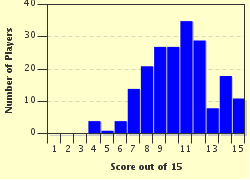Quiz Answer Key and Fun Facts
1. It might have been premature to call a 1901 murder "The Crime of the Century," but as it was the assassination of a president, it's understandable. Who was the president?
2. The New Orleans Axeman attacked victims with an axe, usually one belonging to the victims. Most of the victims were Italian-American grocers. In March of 1919, a letter claiming to be from the Axeman was sent to several newspapers, which all published it on the 13th. It said that there would be another murder at 15 minutes past midnight the night of March 19, but any place where a particular kind of music was playing would be passed over. Bars and clubs were filled to capacity if they had a band playing, and anyone with a phonograph or piano played a marathon session that night. What type of music did the Axeman request?
3. The police discovered the bodies of the victims of the Saint Valentine's Day Massacre of 1929 due to the howling and barking of a German Shepherd Dog.
4. Charles Augustus Lindbergh, Jr. was kidnapped from his parents' New Jersey home in 1930. Under supervision of the police and FBI, a ransom was paid, taking what special measure with the bills?
5. The "Brinks Job" of 1950 was the armed robbery of the Brink's Building in Boston, Massachusetts. In the largest robbery in US history up to that point, the robbers got away with $1,218,211.29 in cash, and $1,557,183.83 in checks, and other securities. But the entire eleven-member gang who pulled it off was eventually arrested.
Was it true that there was only a single day left on the statute of limitations at the time of the arrests?
6. "The Lana Turner Affair" of 1958 refers the death of Turner's on/off lover, Johnny Stompanato, at the hands of Cheryl, Turner's 14-year-old daughter.
7. When John F. Kennedy was shot in 1963, he was the first assassinated president to die immediately from his wounds, rather than lingering for several hours or weeks. Very soon after the assassination, a special honor was bestowed on Kennedy, one that had been bestowed on only four previous presidents and one founding father. What was it?
8. The Tate-La Bianca Murders of 1969 are often often referred to by another name. What is it?
9. One of the members of the Symbionese Liberation Army who participated in the Patty Hearst kidnapping was Emily Harris. What was Emily Harris' job before she kidnapped Patty Hearst in 1974?
10. On March 30, 1981, 69 days into his presidency, an attempt was made on the life of Ronald Reagan. Reagan survived the attempt, despite serious wounds, probably more serious than the wounds that caused the infection that killed President McKinley. Reagan was not the only one wounded that day. Who else was shot?
11. In 1982 in Chicago, several people died suddenly, and strangely of cyanide poisoning. After more deaths the cyanide was was traced to tainted analgesic capsules available over-the-counter. The deaths included two people who died after returning to the apartment of a deceased relative after his funeral suffering from headaches; they looked through his medicine chest for something to take for relief, and then died just as he had. Only one brand was involved. What brand was it?
12. America's biggest art heist was the 1990 theft of 13 precious works, valued at the time at around $500 million. From where were these works stolen?
13. In the spring of 1994, the public was shocked by the news that Nicole Brown, the ex-wife of former football player O.J. Simpson had been murdered, along with her acquaintance, Ron Goldman. Goldman was a waiter at a restaurant Nicole Brown had attended earlier that evening, and he had come by her home to return something her mother had left behind at the restaurant. What was the item?
14. Between 1978 and 1995, an unknown terrorist waged a bombing campaign against modern technology by planting or mailing homemade bombs to a several locations across the US. Because his original targets were universities and airports, he was nicknamed the "Unabomber." His anti-technology screeds became known, as he sent letters to several papers, promising to "desist from terrorism" if his manifesto was published.
When he was captured, where was he living?
15. On April 20, 1999, at Columbine High School in Columbine, Colorado, a massacre took place over several hours; rescue workers could not get to injured students, and many who died or suffered devastating wounds did so because of lack of emergency treatment. In addition to the shootings, the attack involved bombs to divert firefighters, propane tanks rigged to explode in the cafeteria, and many other explosive devices. If anything was fortunate about this episode, it was that most of the bombs failed. Twelve students and one teacher died; 21 others were injured, some quite grievously. Three were injured not by the shooters, but in escape attempts. The two shooters ended things with their suicides.
What were the names of the shooters?
Source: Author
RivkahChaya
This quiz was reviewed by FunTrivia editor
bloomsby before going online.
Any errors found in FunTrivia content are routinely corrected through our feedback system.

